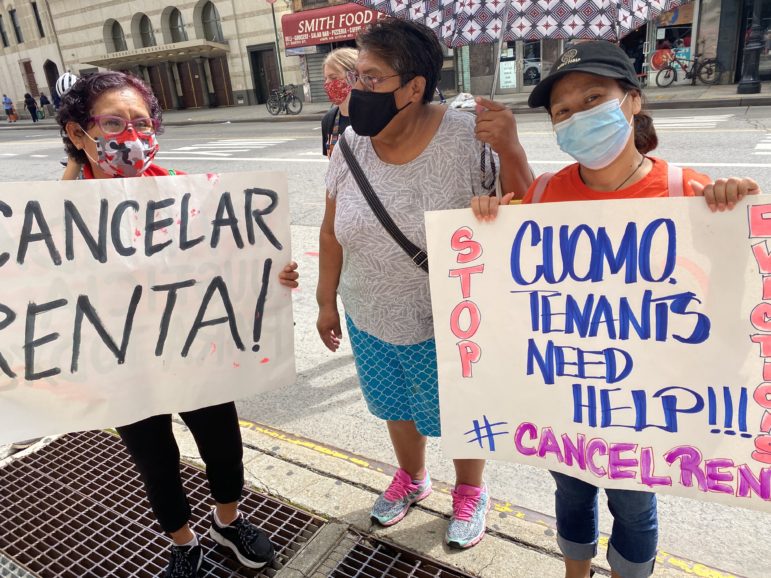‘The program’s eligibility requirements are so stringent that very few tenants actually end up qualifying. The state now runs the risk of losing the remaining available funds to the federal government if it does not distribute them by Dec. 30, as legally required by the CARES Act.’

Sadef Ali Kully
Tenants rallying for rent relief this past summer.In the early months of the COVID-19 pandemic, the federal government through the CARES Act dispersed billions of dollars to states that could be used for rental assistance for families who have been hit hardest by the coronavirus. The COVID Rent Relief Program was intended to provide eligible households with a one-time rental subsidy that would be sent directly to the household’s landlord; applicants would not need to pay it back.
Out of the billions of dollars that New York received, the state chose to use $100 million for rent relief in the beginning of the summer—an amount that could make a considerable impact in the lives of tens of thousands of New Yorkers. Yet, it’s now nearly the end of the year and the state has distributed only $40 million out of that $100 million in rent relief funds. Out of 94,000 people who sought relief through the program, only 15,020 were approved. The state now runs the risk of losing the remaining available funds to the federal government if it does not distribute them by Dec. 30, as legally required by the CARES Act.
To make matters worse, the statewide eviction moratorium also expires at the end of December, and will likely push many struggling tenants across New York into a new bleak scenario: the very real possibility of losing one’s home and facing homelessness.
So why is New York State still holding onto $60 million in federal rent relief funds when New Yorkers could massively benefit from that money right now? It turns out that the program’s eligibility requirements are so stringent that very few tenants actually end up qualifying. To qualify, household income must have been below 80 percent of the area median income, adjusted for household size, and the household must have been paying more than 30 percent of gross monthly income towards rent. Additionally, New Yorkers who receive unemployment insurance are ineligible (despite that the federal CARES Act’s $600 weekly pandemic payments lapsed, and benefits have been drastically reduced since then) and undocumented New Yorkers cannot apply directly.
This is the situation Cecilia, a 65-year-old longtime resident in Crown Heights, Brooklyn, is facing. She was among the 94,000 renters who applied for the program, after the federal pandemic aid was cut in half and the second round of payments expired. These supplement benefits were a lifeline for Cecilia, who receives about $260 a week in regular unemployment insurance after working part-time for Hallmark Cards before the pandemic. She was able to save up bit-by-bit to cover June and July rent, but her scarce unemployment benefits and disability insurance from a bad fall two decades ago were insufficient to cover the rest of her rent and other bills. Since then, she has not been able to afford her payments and is now four months behind in rent.
Cecilia applied for the rent relief program this summer, but has yet to receive word on whether she’ll get some aid. Unfortunately, it is unlikely that she’ll be approved since she’s receiving unemployment benefits, regardless of how modest the amount is.
However, these strict eligibility restrictions are not set in stone. They are modifiable and Governor Andrew Cuomo and the legislature have the power to amend them. In fact, an analysis by The Legal Aid Society found that other states, including Connecticut, Delaware, Maine, Massachusetts, and Washington, amended their respective rent relief programs earlier this year to maximize the number of needy families eligible for relief. New York State can and should do the same.
The state’s division of Homes and Community Renewal (HCR),which is responsible for the distribution of the COVID Rent Relief Program, states on its website that it “will prioritize eligible households with ‘greatest economic and social need’ accounting for income, rent burden, percent of income lost and risk of homelessness.” We need our state leadership to ensure that HCR can deliver on that promise and that those who truly have the greatest economic and social need qualify to actually receive funds.
Judith Goldiner and Ellen Davidson work for The Legal Aid Society’s Civil Law Reform Unit, where Goldiner is the attorney-in-charge and Davidson is a staff attorney.









One thought on “Opinion: Albany Must Fix Rent Relief Program To Serve More NY Families In Need”
I applied in July and still no word on if I am approved or denied. I called several times over the last 4 months, even speaking to supervisors and they keep saying I should hear soon, each month I tell my landlord they say a decision will be soon, the look in his face tells me that he thinks I am lying, I don’t blame him. It’s July, August, September, October, November and now December is here. I deserve an answer so I can go forward with any options I still have. I just received eviction papers today. I am very worried. Can you help me in any way ? Maybe make an inquiry on my behalf ? I should at least be told where I stand on my application. Please help if you can. Thank You